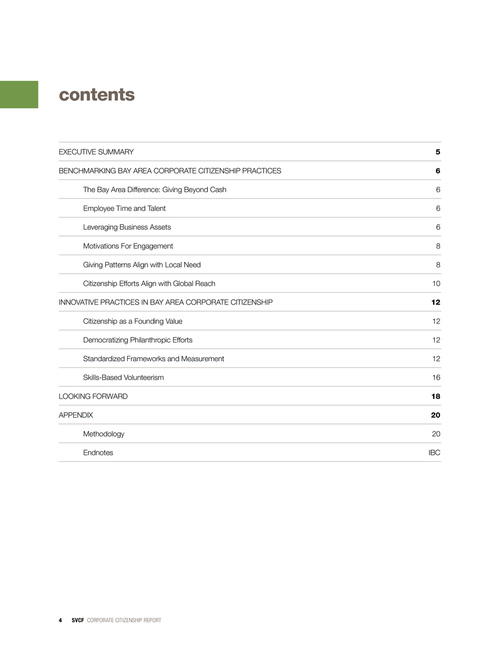
contents
EXECUTIVE SUMMARY BENCHMARKING BAY AREA CORPORATE CITIZENSHIP PRACTICES The Bay Area Difference: Giving Beyond Cash Employee Time and Talent Leveraging Business Assets Motivations For Engagement Giving Patterns Align with Local Need Citizenship Efforts Align with Global Reach INNOVATIVE PRACTICES IN BAY AREA CORPORATE CITIZENSHIP Citizenship as a Founding Value Democratizing Philanthropic Efforts Standardized Frameworks and Measurement Skills-Based Volunteerism LOOKING FORWARD APPENDIX Methodology Endnotes 5 6 6 6 6 8 8 10 12 12 12 12 16 18 20 20 IBC
executive summary
The nine-county Bay Area region is a place of innovation, attracting talented individuals and supported by local infrastructure and resources. This creative landscape translates into a culture of corporate citizenship in the region; one that has continued to evolve along with the emergence of new leadership, companies, and industries. Bay Area companies are clearly committed to corporate citizenship. In fact, those companies participating in national and local surveys alone contributed $2 billion in philanthropic contributions to local and global causes in 2012. Corporations not only provide substantial financial support to nonprofits, but also leverage employee expertise and creativity, distinctive products and services, and collaborations with other for-profit funders and nonprofit organizations. Together, these strategies are shaping a new kind of higher-leverage approach to corporate citizenship.
Bay Area companies are clearly committed to corporate citizenship. In fact, those companies participating in national and local surveys alone contributed $2 billion in philanthropic contributions to local and global causes in 2012.
Key findings in this report include: •
The biggest difference between Bay Area and national companies is in the share of non-cash contributions. Bay Area companies reported that 56 percent of the value of their contributions was non-cash, including employee time and expertise and company products and services, compared to 18 percent of all companies in the national sample. The amount of giving per employee for Bay Area companies is nearly 20 percent higher than the national average. In fact, Bay Area companies gave a median amount of $739 per employee compared to the national sample of $620 in 2012. Bay Area companies’ international giving is more diversified than the national average. The region focuses a greater percentage of its efforts on Europe, the Middle East, Africa and Asia Pacific than the national average. Employee engagement programs are a cornerstone of citizenship efforts and are extended to global employees. Seventy-six percent of Bay Area companies offer both domestic and international employee-volunteer programs, compared to the national average of 60 percent. Looking forward, based on the findings in this report, corporate citizenship in the Bay Area is likely to evolve in the following ways: • • It will become more integrated into core business models and operations, and will become more connected to diverse entities outside the corporation. Corporate citizenship decision-making will become more distributed. Instead of executive-run programs, employees will increasingly drive efforts and likely pioneer new approaches. There will be a growing emphasis on accountability in corporate citizenship, which will drive a stronger commitment to measuring impact. Companies will be increasingly interested in sharing innovative practices, working on shared challenges (e.g., impact measurement) and exploring potential strategic partnership opportunities. Near term, there is clearly a need and growing interest in developing a more strategic, collaborative approach to working on K-12 education.
•
• •
•
• •
Bay Area companies are looking to move to a higher-leverage corporate citizenship model, one that taps more company assets and achieves better community results.
Bay Area companies are looking to move to a higher-leverage corporate citizenship model, one that taps more company assets and achieves better community results. To do so, companies will need to be more creative and effective in how they leverage employee engagement and executive leadership, as well as strategic partnerships and measurement.
4 SVCF CORPORATE CITIZENSHIP REPORT SVCF CORPORATE CITIZENSHIP REPORT 5